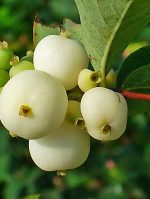 Also known as waxberry, this deciduous flowering shrub is a member of the honeysuckle family, Caprifoliaceae, that also includes weigelia, scabiosa, and abelia. It is native to North America where it grows in dry, open woods from Alaska and the Northwest Territories south to California and Colorado, and east to Virginia. Plants are valuable for control of soil erosion and wildlife management as they provide food and cover for birds and small mammals, and browse for livestock and large mammals.
Also known as waxberry, this deciduous flowering shrub is a member of the honeysuckle family, Caprifoliaceae, that also includes weigelia, scabiosa, and abelia. It is native to North America where it grows in dry, open woods from Alaska and the Northwest Territories south to California and Colorado, and east to Virginia. Plants are valuable for control of soil erosion and wildlife management as they provide food and cover for birds and small mammals, and browse for livestock and large mammals.
Description: Snowberry is a rhizomatous, much branched shrub growing 3-6′ tall and wide. It bears dull green oval leaves 1-2″ long that are sometimes deeply lobed and clusters of small, pinkish white flowers that are bell shaped and hairy inside. The flowers appear in summer and give way to pale green pea-sized berries that gradually turn white and waxy, and persist into winter.
Poisonous Properties: The berries are considered toxic especially to children. They contain viburnin that consists of several alkaloids and saponins of unknown toxicity. Symptoms of ingesting the berries include vomiting, gastrointestinal irritation, blood-stained urine, dizziness, delirium, and sedation.